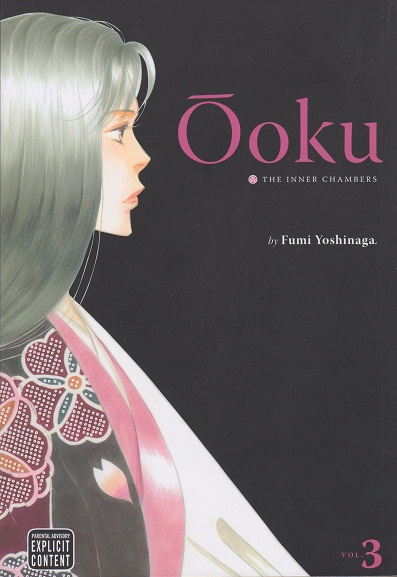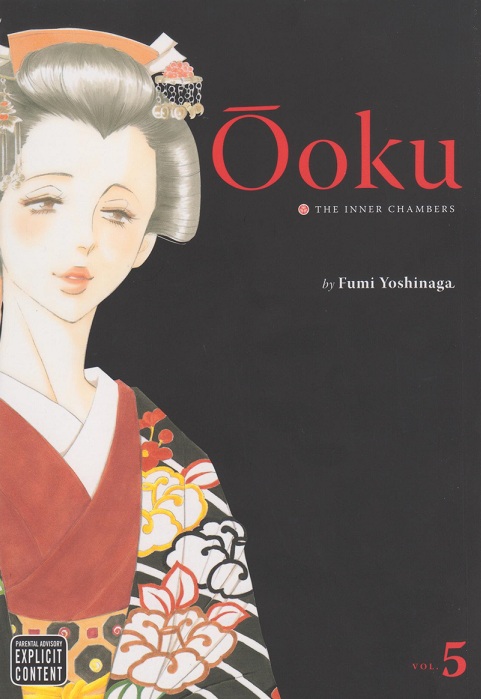Well, this was turning into a bigger undertaking than I had imagined (and also, Friday was Debbie Reynolds’s birthday on TCM), so I’m turning this into a two-parter (though the second part should be much shorter). When I first started reading Ōoku The Inner Chambers, I was immediately taken in by the feminist tones and the role reversals in the story. Due to a strange plague that swept through Japan, wiping out a large chunk of the male population, the women of Japan have been taking over the duties and positions that once belonged to the men by law and custom. Even the role of the Shogun, Japan’s ruler, has become a woman’s position, due to the fact that there have been no male heirs. Everything changes. Women work the fields, women run the shops, women inherit land and titles, men become little more than seed stock, the Shogun’s Inner Chambers that were once filled with women to give birth to an heir are now filled with men, and offices in the palace once held by men are now held by women, including the top office, the Shogun. Where women once filled the brothels to give pleasure to men, now men fill them, to allow women many opportunities to become pregnant. Such a reversal is important not only to rebuild the population of Japan, but to try and rebuild the male population. Boys are treasured and pampered, and great care is taken to assure they reach adulthood. Those who do become valuable commodities, and if they are not married off to the highest bidder, are regularly rented out to local women for high sums. It’s a completely different world. Several women hold the post of Shogun in this series, though it barely spans a hundred years. The physical and mental strain on these women is great, and they handle it amazingly, but it can still lead to an early death. Regardless of how long they reign, each woman handles the post differently, based on their own personalities and situations, and also the updated state of the kingdom. The more it becomes evident that the men aren’t making a satisfactory comeback, the more powerful these women are able to become. The journey from Chie, the first female Shogun, to Yoshimune, the present Shogun, is quite telling. Six women hold the post throughout the story (so far, as of volume 6, the most current volume released here), and many of them have a sweeping impact on Japan. Yoshimune is technically the first Shogun, as far as the way the story is structured, but the series quickly goes back in time to the first official female Shogun, Shogun Iemitsu (who takes her father’s place), or Lady Chie.
Chie/Shogun Iemitsu Tokugawa
Chie was brought to Edo Palace to replace her father Iemitsu, who had died young without producing a male heir. Even though she was an illegitimate child, she was the only option, and she was torn from her family and brought to the palace to rule. Forced to dress as a boy, as if she were meant to convince people that the real Iemitsu was still alive, Chie was miserable and hated her situation. In an attempt to escape the oppressiveness of the palace, she left the Inner Chambers on her own, dressed as a boy, but was found and raped by a man. Her virginity brutally taken from her, a pained and humiliated Chie slew the man on the spot. A child was born, but died soon after, sending Chie on an emotional roller coaster ride. Eventually the monk Arikoto was brought into the Inner Chambers and sent to serve in her bedchamber, in order to breed an heir, but though they fell in love, no child came from their union. Other men were brought in to lie with her, and so over and over, like cattle, she was made to mate with man after man in order to provide an heir. Though initially a petulant and selfish child, Arikoto’s gentle hand guided her down a more mature path, his kindness and acceptance of her past a ray of sunshine into the dark and twisted world that is the Inner Chambers. She grew up, and began to make significant changes in the law of the land, including laws that secluded Japan from the outside world (to avoid the spread of the plague, and to keep secret the growing female rule), rules that made it more difficult for other houses to try and oppose the Tokugawa reign, provided her people with food to quell the possibility of rebellion, allowed for women to become domain lords, and even emptied out a portion of the Inner Chambers into local brothels to provide decent seed stock for women who could not afford to go anywhere else. Yet even though she was clearly a capable ruler, Chie never saw herself as anything other than a temporary replacement. Several times in her own words she makes such a point. In volume 4: “‘Twill be in place [allowing women to be domain lords] only until the male population hath regained once more its previous numbers and men can again assume their hereditary titles. This shall be true of the Tokugawa as of any house. Let me assure you that I occupy this seat as nothing more than a custodian, in order to maintain Tokugawa rule and, thus, peace throughout the realm. [….] I was born into this world for the purpose of continuing the Tokugawa reign – a Shogun in name only, and in fact a human sacrifice!” That this beautiful, strong, intelligent woman saw herself as little more than a mean to continue on the Tokugawa line is a tragedy. However, as she was the first woman to take over a patriarchal post, it’s not an unexpected outcome. Many of the people around her wished to believe the same, that eventually the male population would return to its former numbers and the men could take over the rule of the land once more. This was a new situation, and in order to preserve the peace of the country (basically, to avoid a civil war, or war of succession), it was the only option available. Yet even under Chie’s reign, the women of Japan were becoming stronger. A side story through the volumes follows a group of female farmers who gradually take over the field work, and even begin inventing new machinery to help them compensate for being physically weaker than their dwindling male counterparts. The politics of the palace will slowly change, but the common people can’t wait around for some old men to decide what is OK for the women to do; the country has to keep moving, rice has to be grown, the economy has to stay afloat. The people inside the palace will eventually figure this out as well.
It’s interesting to note that Yoshinaga makes mention several times (either through narration or via the characters) of how well Japan runs under the rule of women. With the men focused on just staying alive, and keeping the population going, the women basically run everything. Under the guidance of the decidedly more rational and compassionate women, the country is at peace. The rule of the sword gave way to the rule of law. Yoshinaga’s praise for women goes beyond the political, however. She brings up multiple times that the women are working twice as hard now that the male population has so drastically decreased. Not only do they bear children and run the household, they also do all of the manual labor. An interesting quote in her narration provides much to think on: “The status of men and women had not been reversed. Men had simply ceased to do anything besides sire children. This meant that women took on all the labor in the land, from childcare and housework to the trades and farm work.” And ruled the land while popping out kids left and right, as it was for the Shogun. Anyway, go women!
Chiyo/ Shogun Ietsuna
The first daughter of Chie is quite a departure from her mother. It’s almost painful to read about this pitiful girl after seeing the strength of Chie. Arikoto remained in the Inner Chambers to serve as Chiyo’s guardian, but his gentle nature backfired, and he was unable to help the insipid girl. Chiyo had no interest in ruling, and no interest in men…apart from Arikoto. Her only interests were in the arts, and she enjoyed reading and the theatre. Desperate to turn the young Shogun’s mind to matters of state, Chiyo’s attendants approached Arikoto and pleaded with him to sway her interests. Remarkably, Arikoto did manage to briefly turn Chiyo’s thoughts toward her people, though it’s obvious to the reader she only meant to impress Arikoto and gain his affection. Unfortunately, Arikoto was entirely oblivious to her feelings, and chose himself the man who would be the first to lie with her. When it seemed like things were beginning to move along the right path, a fire swept through the castle, and a passionate Chiyo took that moment to declare her love for a shocked Arikoto. Seeing the tragic relationship he had with her mother flash before his eyes, and indeed reflected in Chiyo’s pleas, Arikoto decided he could no longer remain in the Inner Chambers and promptly left them forever. Sullen, rejected, and alone, Chiyo did little else for the remainder of her reign, and did not even give birth to a single child. She’s an unremarkable addition to the Tokugawa line, and the story of this manga, and really does little more than continue and end Arikoto’s story. A woman of power she was not, and her constant waiving of her duties onto her attendants was a huge step backwards from the progress that her mother Chie made.
Tokuko/Shogun Tsunayoshi
The fifth Tokugawa Shogun took over after Chiyo’s short and empty rule. Tokuko was the daughter of Chie and Gyokuei, Arikoto’s former attendant. Spoiled by her father, Tokuko was used to getting her way, and often flaunted her power to get her way, even if it meant sleeping with the husband of a loyal retainer, and when he grew too old, their married son, if that was her desire. Taught from an early age by her father to put outward beauty before mental enrichment, she also flaunted her beauty to get what she wanted. Unlike Chie and Chiyo before her, Tokuko was not shy about her sex drive, and she had no reservations on how to satiate herself. It was, in a way, an act of rebellion against the oppressive regulations of the Inner Chambers. Her husband, as it became clear that his position in the Inner Chambers was faltering, brought forth a secret weapon, a handsome young man named Emonnosuke with which to tempt the Shogun. Emonnosuke, however, had his own plans, and rather than become another concubine, convinced Tokuko to name him Senior Chamberlain of the Inner Chambers. Tokuko, surprisingly, turned out not to be as capricious as many saw her, but was in fact quite shrewd, and dealt out strict judgments on the domain lords during her reign. She and Emonnosuke made a good match within the Inner Chambers, as they were both clever, willful, and perspicacious. Unfortunately, though her rule had a generally positive impact, Tokuko was also the author of one of the strangest and strangely harmful laws made during the era. After the death of her only daughter, when Tokuko found herself unable to conceive again, her father, Gyokuei, claimed that it was a curse resulting from a kitten he had once killed while he still served Arikoto. To appease her father, Tokuko created the Edicts on Compassion for Living Things, which nearly bankrupted the shogunate with the money spent to feed stray animals. After her daughter’s death, Tokuko also stepped back from governing, distraught over the loss of her child, and under constant pressure to bear another heir. She also began to dote heavily on her aging father. Even in the midst of unrest in the kingdom over the lack of an heir, Tokuko refused to name her successor out of deference to her father, who vehemently disagreed with the popular choice. Yet Tokuko’s reign was long, her popularity plummeted, and before the end, she wondered why she did hang on to life so, when she had long ceased to care for governing, and was sad and tired of life.
Tomorrow I’ll look at the next three female Shoguns, though there is not much left to know right now. Tokuko’s reign goes into volume 6, and the two women between her and Yoshimune are not touched upon much in the leftover pages. Yoshimune, however, has a strong presence in the first volume (and appears as a child in volumes 5 and 6), so most of the focus will likely fall on her.
And now, your daily link update!
Anna at Manga Report comments on the believability of the characters and story in Ichigenme…The First Class is Civil Law.
Connie of Slightly Biased Manga lists each of Yoshinaga’s books along with her opinions of them.
Here is Friday’s feature, a list of my favorite Yoshinaga characters.
And, of course, the archive, which is looking quite robust, I am happy to say!
Kris
kristin@comicattack.net
@girlg33k_kris





Pingback: Manga Moveable Feast: Fumi Yoshinaga August 2011
Pingback: Manga Moveable Feast: The Women of Ōoku Part 2